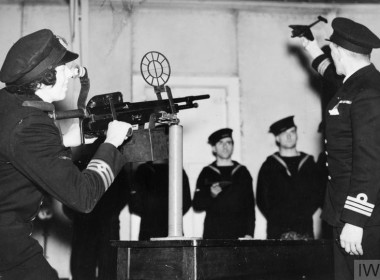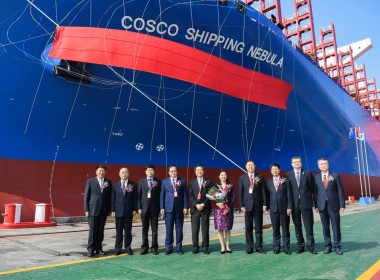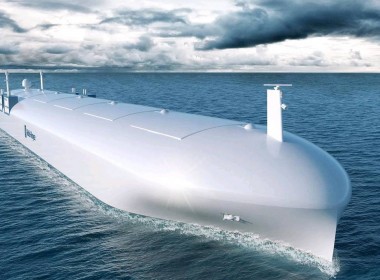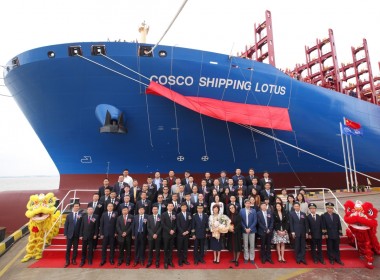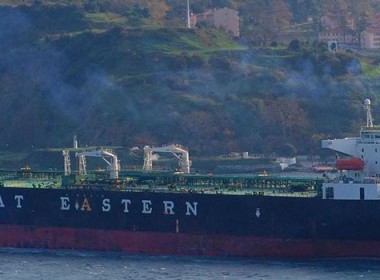COLUMN | Australian shipping hanging by a thread [The Boroscope]
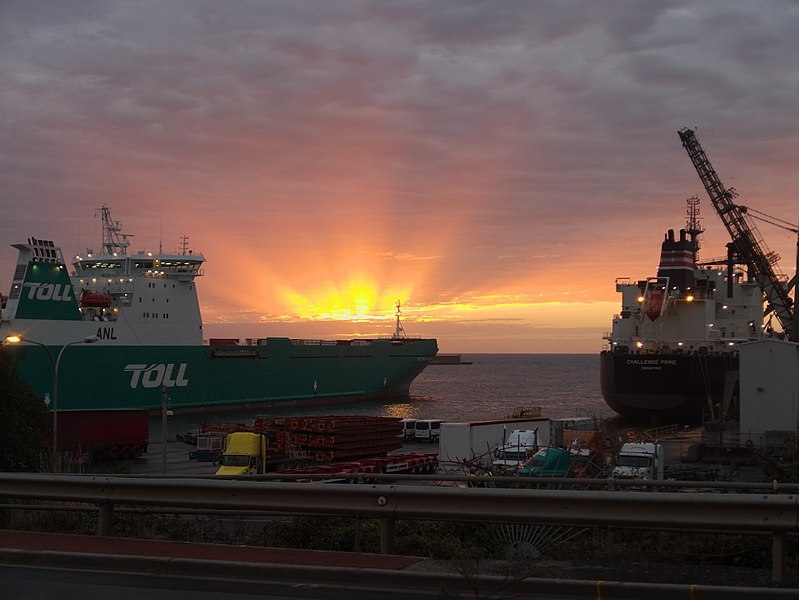
Three years ago, I wrote that the Australian shipping industry was at the crossroads of existence. It’s now hanging by a thread. We have been continually losing ships and jobs but more crucially we have been losing marine expertise.
Our chronically weak shipping fleet has continued to dwindle to a point where I can identify by name the thirteen or so ships still trading under the Australian flag. Australian ships have been forced off our coast at a depressing rate without a murmur. They have briefly made the news with union protests about the loss of jobs but little else has happened. The ships are gone, the jobs are gone and tragically the maritime skills are disappearing far too quickly.
Now we hear that the Australian Navy has a similar predicament. They aren’t losing ships but they are losing manpower. They just don’t have the seagoing personnel to man their ships. The Australian newspaper recently reported that it doesn’t have sufficient crews to man its Anzac-class frigates. Nor can they find enough people for the Collins submarines.
Apparently this lack of recruits exists in the UK, the Netherlands, Germany, Belgium and Denmark as well. Neither commercial shipping nor the navy can attract people to a career at sea. There is the crisis in our maritime industry – a lack of experienced seafarers.
Let’s look at some the facts:
- Australia is a resource rich island nation. Virtually all our trade is by sea yet we don’t have a shipping industry.
- There is nothing to attract people to take up a seagoing career. There’s a skills void which can’t be filled overnight. Particularly if we don’t have any ships at sea.
- We have a handful of commercial ships left and a hopelessly undermanned Navy. You can’t put inexperienced people on merchant navy or grey funnel ships and hope nothing will go wrong. It takes time for people to find their vocation. It then takes time to train them.
- We are given to believe that thousands of kilometres of our unpopulated coast are watched by over-the-horizon radar and surveillance satellites. These are not a deterrent.
- Our naval force has been depleted of manpower and shows no sign of recovery for at least another 10 years (at the time of writing, four of our eight Anzac-class frigates are on hard stand in Western Australia).
- Our commercial shipping industry died of a thousand cuts by successive governments over the last 40 years and with it went our shipbuilding and maritime trading sectors as well.
- Nearly all our traded commodities into and out of Australia are carried by foreign flagged ships.
- We have, on average, about one port visit every 17 minutes. That equates to about 2,500 tonnes of freight per minute, all on foreign-flagged ships.
- We have almost a complete reliance on imported liquid fuel supplies: in itself it’s a “just-in-time” supply (even our air force jet fuel is imported).
- We have diminishing economic strength compared to our Asian neighbours. Specifically, China, India and Indonesia.
Are our borders unprotected? Are they even watched on a regular basis?
Where is all this leading?
A new book by Hugh White, How to Defend Australia, has just been released and makes enlightening reading. It predicts Australia’s position in 10 years to be more precarious, more vulnerable and less secure than it’s ever been in the last 230 years.
Hugh White is a professor of Strategic Studies at the Australian National University and has been a strategic advisor to the Hawke and Howard governments. He is was the principal author of the 2000 White Paper on defence strategy for the Howard government and has argued strongly that Australia, “needs to dramatically increase its maritime capabilities to avoid becoming a small power in Asia”.
He predicts that our reliance for defence support from the US will diminish in the coming years as the economies of our Asian neighbours, specifically China, outstrip the US.
The Australian Treasury predicts that by 2030 the GDP of China will be just over $42 trillion while US GDP will be about $24 trillion. Hugh White predicts that in 2030 our naval strength will be at its weakest since before World War II.
Will we still rely on the US for military support? At the moment they are having tariff wars with our biggest trading partner, China. While Hugh White clearly doesn’t suggest that we will be invaded by our neighbours, our diminished economic position will compromise our trading strength and security relationships with them.
Australia’s political compass seems to have lost its direction. We have inexplicably given a 99-year lease for our most northern port, Darwin, a natural deep-water harbour, to a Chinese company, Landbridge (the name says it all). At the same time, China has enforced the National Intelligence Law (2017) for all Chinese organisations to “support, assist and co-operate” with the Chinese government on security matters. Where do our loyalties lie? With the US or China? Where do we fit in?
I desperately cling to the hope that I’m not the only voice in the wilderness bemoaning the loss of seafaring skills in Australia. I have, in the past, been at a loss as to how to resolve these issues, and how to revive the Australian shipping industry.
Now, with the parlous state of both our commercial shipping industry and our navy, I am offering a glimpse of a recovery path for our maritime capabilities if all (political) parties work together. But there are some fairly significant hurdles to be broached before this will happen, this being one of them.
What I am proposing is the establishment of a commercial fleet auxiliary – a small fleet of subsidised coastal traders competing with the foreign ships trading on permits. They would carry official “observers” to report on unusual or suspicious activity on our exposed coastline.
Admittedly, the concept sounds rather far-fetched and a desperate idea to rejuvenate our maritime industry. But these are desperate times. I’ve run these ideas past some of my colleagues and asked them to pick holes in the idea. These are the responses to their scepticism:
How is a commercial fleet auxiliary supposed to run or even exist?
I propose, through limited government funding, to provide assistance to the few remaining Australian maritime companies to establish a coastal trade of small ships to service major and regional ports around our coast (not unlike the Australian National Line did years ago).
These ships are versatile enough to compete (with the assistance of small government subsidies) with the foreign flagged ships operating on our coast on “permits”. They can challenge the foreign flag feeder services between major ports and with their flexibility, they can service the smaller regional ports that are bypassed by foreign ships. These coastal communities are now only serviced by road – their goods are often double or sometimes triple handled before they reach the customer.
The ships should carry two “observers” from either Border Force and/or the Royal Australian Navy to be the “eyes and ears” around our coast. They should be trained drone pilots able to investigate any suspicious behaviour around our coast and report back to security intelligence authorities ashore. That’s about 100 per cent more surveillance than what we have at the moment. Sounds pretty far-fetched so far? Bear with me and read on.
Where are these ships going to come from?
There is a worldwide surplus of offshore supply vessels desperate for work that isn’t there. Big players like Maersk, McDermott and Bourbon have disposed of hundreds of vessels in an effort to stave off bankruptcy. And those few Australian companies that still survive are struggling for contracts that are few and far between.
An 80-metre platform supply vessel (PSV), for example, can carry up to about 100 containers double-stacked on deck quite comfortably. They can handle breakbulk, oversized machinery and other items that are too big for road transport and can deliver goods to small regional ports that aren’t serviced by foreign flagged ships (trading on coastal permits). They can berth without tugs or pilots and can steam at a very respectable 13 to 14 knots.
How would one set about starting this service?
This is the most pressing issue to get this concept to work. It requires political will. There are dozens of minor details to be sorted out beforehand but there must be a bipartisan approach to this or it will never work. It should never become a political tool of either major parties.
From the outset it must involve the maritime unions if they choose to support the idea. If they don’t, then it’s doomed to fail. Collaboration with the employers is vital to its success. With their rapidly declining membership the unions must surely support any lifeline to survive.
How do we man them?
This is the second most pressing issue to be dealt with. With what remains of the Australian seafaring workforce, there still exists some maritime expertise. But there are huge hurdles to be overcome here. There are still bitter memories of union militancy that many still believe played large part in the collapse of the industry. There is no place for this now.
In the past the unions were of the opinion that the industry existed for their benefit only. They lost sight of the competitive edge necessary to survive in modern shipping. Today, the enemy of the unions is not the employer but the foreign flagged ships that have taken their jobs. Collaboration not confrontation is the message here. Unless this vital concept is understood by the maritime unions, they will never get their members back to sea. They are doomed to wither like our shipping industry has done.
Who, in their right mind, would try to compete with the foreign flagged feeder ships plying our coast on the so-called “permit system”.
You can almost count them on one hand, but there are still a few Australian marine companies that somehow continue to operate under such oppressive conditions. They would jump at the chance to put their vessels to work on a regular basis, particularly if they are getting support from our government (and our foreign friends weren’t getting a free ride).
But, and it’s a big but, these companies would have to have some rock-solid evidence that the maritime unions are with them all the way. The future is all-important. The unions have to put the past behind them and work together.
How can we compete with foreign ships trading on our coast with such lowly paid crews? How do Australian ships, for example, compete with a foreign ship on a coastal permit which off-loads in Fremantle and has 60-80 spaces available to trans-ship goods to other ports at bargain basement rates?
Let’s put PSVs on these routes competing for cargoes but subsidised from say, levies on foreign ships trading here or from the Defence budget (currently at about AU$38 billion (US$26 billion) per year). These ships can feed other major ports and also carry cargoes to small regional ports which no longer accommodate regular trade.
Let’s throw the challenge out to the maritime unions to beat the opposition, undercut their rates and deliver the goods to the customer faster. As mentioned before, they can operate without tugs or pilots and they can reduce the burden on our road systems.
What are they supposed to do?
The most obvious activity is watching our exposed northern coastlines. Simply by trading regularly along these routes, carrying cargoes bound for Australian customers, they can provide border security and surveillance, investigate suspicious behaviour, report on illegal EEZ incursions, conduct emergency response and search and rescue missions, simply by “being there”.
What services ashore are they supporting?
Obviously, the need for schedulers and planners to place and plan the cargoes. The ships could almost work on a spot cargo basis provided they got some form of financial assistance. Remember that they are still generating income as they trade. Then, of course, there are all the support services needed to operate an Australian shipping fleet. Repairs, dry-dockings, providoring, cargo handling and so on- Australian jobs.
Will this service need a 10-year period to bring it into service?
No. It can be almost immediate. In 10 years, we won’t even have a maritime industry. The marine companies would gladly grasp the idea of getting more ships trading around our coast. Direct jobs, training, building expertise, support facilities ashore – the opportunities for more and more jobs exist.
It’s never been done before.
Well, actually it has. In one form or another the British RFA (Royal Fleet Auxiliary) does something similar (without carrying cargo) and the US had a program in the 1970s using commercial ships for troop carriers and warfare assist roles (now known as Military Sealift Command).
This Australian proposal is slightly different in that it is a profit generating venture to provide jobs and opportunities for people to pursue a seagoing career.
Would the US ever abandon their support for us?
We don’t know. Their current support doesn’t cost them very much and provides them with a forward base in Asia. We would be naïve to think that the US would put our interests before its own. We only have to look back at how the British left us in 1942 in Singapore. If it wasn’t for our own soldiers on the Kokoda track and the joint Australian/US forces in the Battle of the Coral Sea, we very likely would have been invaded. It was a close-run thing.
When we know what is happening on our coast, we will have a better idea where our defence requirements should be. Currently we are blissfully unaware of who or what can approach our coast. Satellites and over-the-horizon radar may “identify” incursions into our waters but there is no substitute for the visual deterrent of Australian flagged ships trading in these exposed waters and reporting what they see.
Where will we be in 10 years time when the nearest and biggest economies of our Asian neighbours (China, India and perhaps even Indonesia) outstrip the US? Will we be left to defend our own shores? It’s almost inconceivable that we would have a navy and no merchant marine. Or more to the point, no experienced seafarers. We need “eyes and ears” on our coast now like never before. A commercial fleet auxiliary could provide just the layer of security we need. This is really the last roll of the dice.


